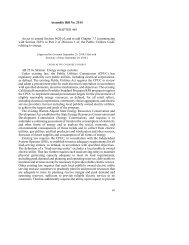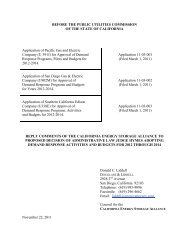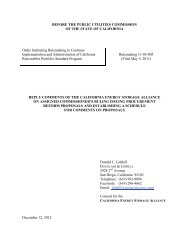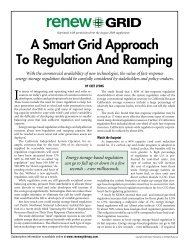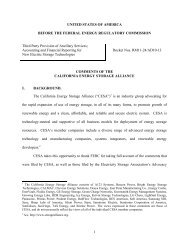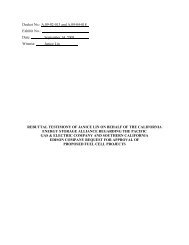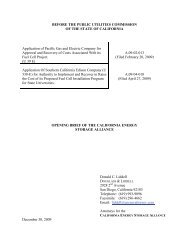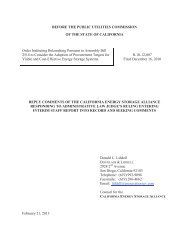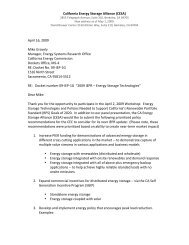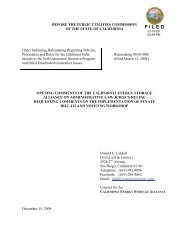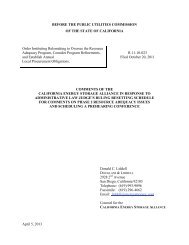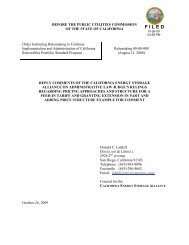DG/Storage Interconnection ALJ's Ruling Comments - California ...
DG/Storage Interconnection ALJ's Ruling Comments - California ...
DG/Storage Interconnection ALJ's Ruling Comments - California ...
Create successful ePaper yourself
Turn your PDF publications into a flip-book with our unique Google optimized e-Paper software.
BEFORE THE PUBLIC UTILITIES COMMISSIONOF THE STATE OF CALIFORNIAOrder Instituting Rulemaking on the Commission’sOwn Motion to Improve Distribution Level<strong>Interconnection</strong> Rules and Regulations for CertainClasses of Electric Generators and Electric <strong>Storage</strong>Resources.R.11-09-011Filed September 22, 2011OPENING COMMENTS OF THE CALIFORNIA ENERGY STORAGE ALLIANCE ONADMINISTRATIVE LAW JU<strong>DG</strong>E’S RULING TO (1) ISSUE WORKING GROUPPAPER ON AUTONOMOUS INVERTER FUNCTIONALITIES (2) SETCOMMENT DATES AND WORKSHOP (3) ENTER WORKING PAPER INTOTHE RECORD AND (4) ANNOUNCE NEW RULE 21 WORKING GROUPDonald C. LiddellDOUGLASS & LIDDELL2928 2 nd AvenueSan Diego, <strong>California</strong> 92103Telephone: (619) 993-9096Facsimile: (619) 296-4662Email: liddell@energyattorney.comCounsel for theCALIFORNIA ENERGY STORAGE ALLIANCEJuly 31, 2012CALIFORNIA ENERGY STORAGE ALLIANCE
TABLE OF CONTENTSI. INTRODUCTION. ..............................................................................................................1II.III.THE PROPOSED SCHEDULE AND TESTING PROCESSES IN THEWORKING PAPER ARE UNREALISTIC GIVEN THE EXTENSIVE TIMEREQUIRED TO DEVELOP AND TEST NEW STANDARDS. .......................................3THE COMMISSION SHOULD REQUIRE FURTHER SPECIFIC VETTING OFENERGY STORAGE-RELATED ISSUES INCLUDED IN THE WORKINGPAPER. ................................................................................................................................5A. There is Insufficient Basis for Developing Requirements Outside ofExisting National Standards Development Processes. ............................................. 5B. The Proposed Timeline is Unrealistic. ..................................................................... 6C. Uses Cases Are Needed. .......................................................................................... 6D. Trials Are Needed Before Determining Requirements. ........................................... 7E. Cost Implications Should be Considered Before Requirements areAdopted. ................................................................................................................... 7F. Performance Should be Measured at the Point of Common Coupling. ................... 8IV. CONCLUSION. ...................................................................................................................8CALIFORNIA ENERGY STORAGE ALLIANCE
BEFORE THE PUBLIC UTILITIES COMMISSIONOF THE STATE OF CALIFORNIAOrder Instituting Rulemaking on the Commission’s OwnMotion to Improve Distribution Level <strong>Interconnection</strong>Rules and Regulations for Certain Classes of ElectricGenerators and Electric <strong>Storage</strong> Resources.R.11-09-011Filed September 22, 2011OPENING COMMENTS OF THE CALIFORNIA ENERGY STORAGE ALLIANCE ONADMINISTRATIVE LAW JU<strong>DG</strong>E’S RULING TO (1) ISSUE WORKING GROUPPAPER ON AUTONOMOUS INVERTER FUNCTIONALITIES (2) SETCOMMENT DATES AND WORKSHOP (3) ENTER WORKING PAPER INTOTHE RECORD AND (4) ANNOUNCE NEW RULE 21 WORKING GROUPThe <strong>California</strong> Energy <strong>Storage</strong> Alliance (“CESA”) 1 hereby submits these comments onAdministrative Law Judge’s <strong>Ruling</strong> To (1) Issue Working Group Paper On Autonomous InverterFunctionalities (2) Set Comment Dates And Workshop (3) Enter Working Paper Into The RecordAnd (4) Announce New Rule 21 Working Group, issued September 26, 2012 (“ALJ’s <strong>Ruling</strong>”).I. INTRODUCTION.CESA’s comments focus on the technical and related Commission policy implications ofthe discussion of the role of energy storage in the working paper entitled, Candidate DERCapabilities: Recommendations for Updating Technical Requirements in Rule 21 (“Working1 The <strong>California</strong> Energy <strong>Storage</strong> Alliance consists of 1 Energy Systems, A123 Systems, AES Energy <strong>Storage</strong>, AltonEnergy, American Vanadium, AU Optronics, Beacon Power, Bright Energy <strong>Storage</strong>, BrightSource Energy,CALMAC, Chevron Energy Solutions, Christenson Electric Inc., Clean Energy Systems Inc., CODA Energy, DeeyaEnergy, Demand Energy, DN Tanks, Eagle Crest Energy, East Penn Manufacturing Co., Energy Cache, EnerVault,FAFCO Thermal <strong>Storage</strong> Systems, FIAMM Group, FIAMM Energy <strong>Storage</strong> Solutions, Flextronics, ForesightRenewable Systems, GE Energy <strong>Storage</strong>, Green Charge Networks, Greensmith Energy Management Systems,Growing Energy Labs, Gridtential Energy, Halotechnics, Hecate Energy LLC, Hydrogenics, Ice Energy, InnovationCore SEI, Invenergy, KYOCERA Solar, LightSail Energy, NextEra Energy Resources, OCI Company Ltd.,Panasonic, Parker Hannifin, PDE Total Energy Solutions, Powertree Services, Primus Power, RedFlowTechnologies, RES Americas, S&C Electric Co., Saft America, Samsung SDI, Sharp Labs of America, SilentPower, SolarCity, Stem, Sovereign Energy <strong>Storage</strong> LLC, Sumitomo Corporation of America, TAS Energy,UniEnergy Technologies, and Xtreme Power. The views expressed in these <strong>Comments</strong> are those of CESA, and donot necessarily reflect the views of all of the individual CESA member companies. http://storagealliance.orgCALIFORNIA ENERGY STORAGE ALLIANCE1
Paper”) that was prepared by the “Smart Inverter Working Group”. 2CESA has serious concernsregarding the recommendations identified in the Working Paper and the process by which theserecommendations were developed.As a threshold matter, it important to recognize that the Working Paper in no way reflectsa general consensus on the issues it raises. The Working Group that developed the set ofrecommendations in the Working Paper does not appear to have included adequaterepresentation from the inverter, distributed energy resource (“DER”), or energy storageindustries whose businesses would be profoundly affected were the recommendations includedin the Working Paper adopted. Accordingly, CESA believes the Working Paper does notprovide a reasonable starting point for the discussion of future inverter and energy storagesystem capabilities and requirements. Instead, a working group with a more representative set ofstakeholders from the DER and energy storage industries should be formed and tasked withdeveloping a set of priority use cases and recommendations that reflect a truly consensus positionon the direction of future inverter and energy storage requirements.The Energy Division Workshop held on June 21, 2013, was a useful step, but it did notdelve to any depth into issues specific to energy storage that are only now surfacing assubstantial impediments to deployment of deployment of DER integrated with energy storage.CESA accordingly recommends that the Energy Division should be directed to hold a second2 On February 13, 2013, the Commission announced the formation of the “Smart inverter Technical WorkingGroup” (“Working Group”) to explore inverter functionalities. At the Workshop held on June 21, 2013, it wasstated by Energy Division staff that the Working Group was tasked with first identifying what advanced invertercapabilities would be beneficial, and that the <strong>California</strong> Energy Commission supports the effort via technicalsupport. The ALJ’s <strong>Ruling</strong> points out that the authors of the Working Paper are a group of engineers, industry,regulators and advocacy groups that was not established under the auspices of the Commission (p. 2).CALIFORNIA ENERGY STORAGE ALLIANCE2
Workshop that focuses exclusively on energy storage topics discussed in the Working Paperbefore Reply <strong>Comments</strong> are due on August 30, 2013. 3A preliminary list of the topics touched on in the Working Paper that should be discussed,at a second Workshop is attached to these comments in the form of extracts from the WorkingPaper as Appendix A. CESA anticipates that some or all of the topics identified in Appendix A,and perhaps others, may be addressed by opening comments filed by other parties and thereforereserves the right to comment on them in reply comments.II.THE PROPOSED SCHEDULE AND TESTING PROCESSES IN THE WORKINGPAPER ARE UNREALISTIC GIVEN THE EXTENSIVE TIME REQUIRED TODEVELOP AND TEST NEW STANDARDS.CESA applauds the Commission’s leadership on the subject of interconnection that isrecognized on a national basis. However, it will be difficult and costly to have <strong>California</strong>specificstandards that are inconsistent with national standards. In an ideal world, it would be farbetter to have <strong>California</strong> adopt national standards that are already under development. CESArecognizes that while IEEE 1547 and UL 1741 are being revised, those processes take years, and<strong>California</strong> is seeing, and is likely to see more, problems before IEEE and UL adopt a newnational standard.In the meanwhile, the Commission should take care not to adopt standards orrequirements that have unintended consequences. In particular, the testing processes laid out inthe Working Paper are unclear and will likely create a great deal of uncertainty for energystorage industry participants. The proposed extensive suite of solutions represents an“everything and the kitchen sink” approach that will likely impose substantial cost anduncertainty on the energy storage industry without sufficiently justifying those costs. The3 For example, energy storage functionality is already built into some commercially available inverter equipment,but energy storage equipment manufacturers should not be forced into multiple certifications for the same equipmentif <strong>California</strong> changes its requirements ahead of IEEE and/or UL.CALIFORNIA ENERGY STORAGE ALLIANCE3
following are just three representative examples of requirements that are either unclear or mayhave detrimental unintended consequences for project development:Example 1:1.5.1 Mandatory Autonomous DER Functions (page 5 + described in greater detail inTable 1, page 15)4. Provide volt/var control through dynamic reactive power injection throughautonomous responses to local voltage measurements.6. Counteract voltage excursions beyond normal limits by providing dynamic currentsupportCOMMENT: The mandatory “volt/var” and “dynamic current support” functions soundvery similar. It should be clarified whether these are in fact different functions, and if so, howthey are different.Example 2:1.5.2 Mandatory DER Functions Requiring Communications (item 9 on page 6, anddescribed in more detail Table 2, page 19):9. Limit maximum real power output at the PCC upon a direct command from the utility.COMMENT: Because “limit maximum real power output” is a mandatory function, it shouldbe clarified under what circumstances the power output would be limited. Although examples of“unusual or emergency conditions” and “… to ensure fairness across DER systems” are given,the lack of conditions or limits in Attachment 1 of the Working Paper could mean that thisfeature could be used in an arbitrary fashion to limit DER output. This potential arbitrarylimitation could have detrimental effects on the ability of DER projects to secure projectfinancing.Example 3:On pages 24 and 25, the sentences describing the alternatives to the WECC load sheddinglimits contain errors.CALIFORNIA ENERGY STORAGE ALLIANCE4
COMMENT: The location of the alternative values to the WECC load shedding limits shouldbe clarified.III.THE COMMISSION SHOULD REQUIRE FURTHER SPECIFIC VETTING OFENERGY STORAGE-RELATED ISSUES INCLUDED IN THE WORKINGPAPER.CESA recognizes that the purpose of the Working Paper is to advance development ofrecommendations for updating Rule 21 in order to enable utilization of DER functions notcurrently allowed by utilities for inverter interfaced technology and to recommend additionalDER capabilities for interconnected renewable DER paired with energy storage systems. CESAalso notes that a number of issues discussed in the Working Paper relate specifically to energystorage. At a minimum, these energy storage-related issues include the following:A. There is Insufficient Basis for Developing Requirements Outside of ExistingNational Standards Development Processes.Before committing <strong>California</strong> to develop an independent set of requirements a strong caseneeds to be made that the national standards making processes are inadequate. A unique<strong>California</strong> set of requirements creates challenges for industry as manufacturers are forced toeither develop products that meet different standard depending on the market their products arelikely to be deployed in, or develop products that meet the most expansive set of requirementswithin any of the markets they serve. Both of these options are likely to increase costssubstantially relative to working through national standards making bodies. Additionally to thedegree <strong>California</strong> moves forward independently, it will need to establish its own processes,which seems likely to create substantial uncertainty for market participants. In contrast, almostby definition, existing processes are well understood by market participants.There may be reasons for <strong>California</strong> to move forward independently, for example, if thereare pressing issues that need to be addressed in a time frame that cannot be realized via nationalCALIFORNIA ENERGY STORAGE ALLIANCE5
standards development processes or are unique to <strong>California</strong>. However, at this point that casehas not been made. If the Commission finds that there is sufficient justification for developingstandards independently, it will be critical that such standards are well-coordinated with thenational standards development process.B. The Proposed Timeline is Unrealistic.The timelines proposed are not feasible and need to be substantially modified to reflectthe practical realities of any standards development process. Experience suggests that it takes aminimum of 6-18 months to develop new product functionality, plus an additional 3 - 6 monthsto undergo Nationally Recognized Testing Laboratory (“NRTL”) certification testing, plus anyadditional third-party testing that may be required. These timeframe are in the context ofdeveloping to a clearly defined standard. It is simply not reasonable to expect that NRTLswould be able to manage the hundreds of inverter companies that would need to recertifyproducts to any new standard within one to two years, much less by the end of 2013.As example, during the last update of UL1741 (on which a much smaller industry hadmany years of input and insight) the NRTL certifying bodies were overwhelmed by the volumeof work required in updating existing product certifications. The recommendations in theWorking Paper, if adopted, would appear to represent a challenge of orders of magnitude greaterthan this example. The Commission needs to be realistic about the time and process required.C. Uses Cases Are Needed.The utilities have not defined uses cases for when the features described in the WorkingPaper are needed. It will be questionable if and when they are needed at all if use cases don’texist. It would be helpful for the Commission to require specific examples of the issues inquestion, and in particular, how widespread such issues are. This is very important as it can take18+ months to redesign and certify an inverter. It would be particularly helpful for stakeholdersCALIFORNIA ENERGY STORAGE ALLIANCE6
to understand the actual technical reasons for requested changes, particularly given the fact thatthere are many tens of thousands of solar PV systems and hundreds of integrated energy storagesystems with these projects already operating successfully in <strong>California</strong>.D. Trials Are Needed Before Determining Requirements.The features described in the Working Paper need to be utilized on a trial basis with asubset of systems to demonstrate that the technology satisfies the use cases before an industrywidetechnical requirement is recommended to the Commission. The initial phase ofimplementation should be permissive rather than mandatory.Going forward, CESArecommends that any resulting changes be accomplished without disrupting the market andmarket viability of installers, customers and manufacturers. Clear criteria need to be issued farin advance so as to avoid delays in design, finance and interconnection.E. Cost Implications Should be Considered Before Requirements are Adopted.In addition to the time and resources required to identify and develop incrementalinverter requirements, once new requirements are adopted, there are likely to be significant costimplications that will need to be addressed. For example, certain functions that smart invertersmay be capable of providing, such as voltage support, may reduce the output from distributedenergy resources, thus adversely affecting project economics. Additionally, the impact ofimplementing additional requirements are likely to vary by project size and context. Forexample, imposing additional requirements on existing systems is likely to be far more expensivethan if those requirements are applied on a going forward basis only. Similarly, the ability ofsmaller projects to reasonably absorb any additional costs is likely to be limited compared tolarger projects. Careful consideration will be need to be given to all of these issues to ensure thatwell-intentioned efforts do not come at the cost of market development.CALIFORNIA ENERGY STORAGE ALLIANCE7
There is a measurable cost required to implement and operate inverters with the featuresdescribed in the Working Paper. The party that pays for the added cost should bedetermined, and the Commission should understand how much and how often the utilities arelikely to use the features described in the Working Paper. Further, costs and benefits are likelyto vary by system size. CESA therefore recommends identification of a minimum projectthreshold size above which mandated requirements would apply.F. Performance Should be Measured at the Point of Common Coupling.Power flows may need to comply with well-defined performance specifications at thepoint of common coupling (“PCC”), not at the actual inverter. This requirement needs to beclarified and the performance specification should be defined at the PCC. Additionally,controlling power flows at the PCC is very difficult and prohibitively expensive for small DER.The Rule 21 Working Group should be directed to determine an appropriate size below whichthe power flow controls would apply at the DER output point instead of the PCC. To ensure thatequipment meets utility‐specific requirements, utilities should test to performance requirementsthat are uniform among utilities, and based on published standards.IV.CONCLUSION.CESA appreciates this opportunity to comment on the ALJ’s <strong>Ruling</strong> and looks forward toworking with the Commission and parties to this proceeding going forward.Respectfully submitted,Donald C. LiddellDOUGLASS & LIDDELLJuly 31, 2013CALIFORNIA ENERGY STORAGE ALLIANCECounsel for theCALIFORNIA ENERGY STORAGE ALLIANCE8
APPENDIX A“1.5.3 Recommended Autonomous DER FunctionsIt is recommended that the following autonomous DER functions should be recommended for<strong>California</strong>: . . . 3. Set or schedule the storage of energy for later delivery, indicating time to startcharging, charging rate and/or “charge‐by” time” (p. 5).“Facility DER management system (FDEMS) interactions with one or more DER systems. TheFDEMS receives software application settings, utility commands, and demand response pricingsignals, and then updates DER settings to reflect that information . . . – Additional scenariosinclude an ISO/RTO managing a large storage device through Automatic Generation Control(AGC) or requesting a specific power factor at the PCC of a wind farm.– A microgrid scenario would include a FDEMS managing the intentional islanding of themicrogrid and then coordinating the generation, storage, and load elements to maintain microgridstability through the combination of setting autonomous settings for some DER systems andissuing direct commands to other DER systems.” (p. 10).“Table 1: Mandatory autonomous DER functions“Counteract frequency excursions beyond normal limits by decreasing or increasing real powerThe DER system reduces real power to counteract frequency excursions beyond normal limits(and vice versa if additional generation or storage is available), particularly for microgrids.” (p.15).Schedule actual or maximum real power output at specific times The utility establishes (or preestablishes)a schedule (e.g. on‐ peak & off‐ peak) of actual or maximum real power outputlevels at the ECP or PCC, possibly combining generation, storage, and load management. Thereason might be to minimize output during low load conditions while allowing or requiringhigher output during peak load time periods.” (p. 16).Set or schedule the storage of energy for later delivery, indicating time to start charging,charging rate and/or “charge by” time. For a DER system that has storage capabilities, such asbattery storage or a combined PV + storage system or a fleet of electric vehicles. Preset time‐ ofchargevalues can be established. Settings are coordinated between the utility and DERoperator.” (p. 19).“3.5 Optional DER FunctionsProvide backup power after disconnecting from grid. The DER system, including energy storageand electric vehicles, has the ability to provide real power when the site is disconnected fromgrid power. (p. 20).“Provide low cost energy. Utility, REP, or FDEMS determines which DER systems are togenerate how much energy over what time period in order to minimize energy costs. Some DERsystems, such as PV systems, would provide low cost energy autonomously, while storagesystems would need to be managed.” (p. 21).CALIFORNIA ENERGY STORAGE ALLIANCE1
“Issue generation and storage schedules. The DER system provides schedules of expectedgeneration and storage reflecting customer requirements, maintenance, local weather forecasts,etc. (p. 21).“Provide ‘spinning’ or operational reserve as bid into market. The DER system providesemergency real power upon command at short notice (seconds or minutes), either throughincreasing generation or discharging storage devices.” (p. 21).CALIFORNIA ENERGY STORAGE ALLIANCE2



